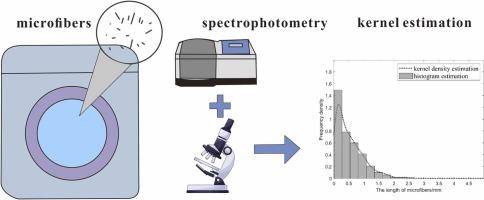一种快速定量测定家庭洗衣过程中释放的微纤维长度分布的新方法
IF 11.3
1区 环境科学与生态学
Q1 ENGINEERING, ENVIRONMENTAL
引用次数: 0
摘要
纺织品磨损释放出微纤维污染物,这是一个重大的环境问题,主要来自家庭洗衣。目前还缺乏一种直接量化水中微纤维并计算其长度分布的方法。本研究旨在建立一种快速定量微纤维的方法,并推导出其长度分布的密度函数。我们通过小规模实验探索了该方法的可行性,评估了方法的准确性和可重复性,并利用实际的洗衣废水对方法进行了验证。研究了两种常用超细纤维悬浮液的质量浓度与吸光度的相关性,建立了回归方程,拟合效果较好。结果表明,吸光度值与质量浓度呈线性关系。通过对全尺寸洗涤过程中微纤维释放量的比较,表明分光光度法和计数法均可用于微纤维的定量。此外,利用核估计得到了超细光纤长度的概率密度函数和分布函数。这两种纤维5次洗涤循环的核函数积分结果都在0.9左右。这些功能便于未来过滤设备的开发和环境影响评估。本文章由计算机程序翻译,如有差异,请以英文原文为准。

A novel approach for rapid quantification and length distribution of microfibers released during domestic laundry
Textile abrasion releases microfiber pollutants, a significant environmental concern, primarily from domestic laundry. A method to directly quantify microfibers in water and calculate their length distribution is lacking. This study aimed to develop a rapid method for quantifying microfibers and to derive a density function of their length distribution. We explored the feasibility of the method through small-scale experiments, assess the accuracy and repeatability of the method and verify the method using actual laundry wastewater. The correlation between the mass concentration and absorbance of two types of common microfiber suspensions was studied and a regression equation was established, showing the fitting effect was satisfactory. As a result, it was found that the absorbance values are linearly related to the mass concentrations. The comparison of microfiber release during full-scale washing showed spectrophotometry and counting method can both be used to quantify microfibers. In addition, by using kernel estimation, we obtained the probability density function and distribution function of microfiber length. The integral results of the kernel function of these two types of fiber for 5 washing cycles are all around 0.9. These functions are convenient for the development of future filtration devices and assessing environmental impact.
求助全文
通过发布文献求助,成功后即可免费获取论文全文。
去求助
来源期刊

Journal of Hazardous Materials
工程技术-工程:环境
CiteScore
25.40
自引率
5.90%
发文量
3059
审稿时长
58 days
期刊介绍:
The Journal of Hazardous Materials serves as a global platform for promoting cutting-edge research in the field of Environmental Science and Engineering. Our publication features a wide range of articles, including full-length research papers, review articles, and perspectives, with the aim of enhancing our understanding of the dangers and risks associated with various materials concerning public health and the environment. It is important to note that the term "environmental contaminants" refers specifically to substances that pose hazardous effects through contamination, while excluding those that do not have such impacts on the environment or human health. Moreover, we emphasize the distinction between wastes and hazardous materials in order to provide further clarity on the scope of the journal. We have a keen interest in exploring specific compounds and microbial agents that have adverse effects on the environment.
 求助内容:
求助内容: 应助结果提醒方式:
应助结果提醒方式:


